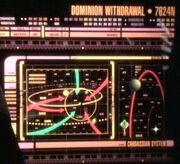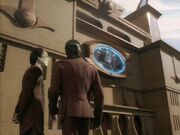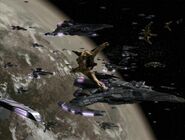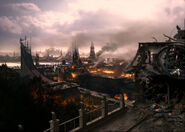Lakenheath72 (talk | contribs) (added info from "The Darkness and the Light") Tag: sourceedit |
Lakenheath72 (talk | contribs) mNo edit summary Tag: sourceedit |
||
| Line 48: | Line 48: | ||
Prior to the militarization of the Cardassian government, Cardassia was home to some of the finest art and architecture in the quadrant. However, the once great Cardassian [[First Hebitian civilization|civilization]] fell in to severe decay. Due to the planet's scarcity in natural resources, the impoverished society suffered from famine and disease, leading to millions of deaths. The [[Cardassian military]] continued this destruction of its heritage in order to fund the [[Federation-Cardassian War]]. ({{TNG|Chain of Command, Part II}}) |
Prior to the militarization of the Cardassian government, Cardassia was home to some of the finest art and architecture in the quadrant. However, the once great Cardassian [[First Hebitian civilization|civilization]] fell in to severe decay. Due to the planet's scarcity in natural resources, the impoverished society suffered from famine and disease, leading to millions of deaths. The [[Cardassian military]] continued this destruction of its heritage in order to fund the [[Federation-Cardassian War]]. ({{TNG|Chain of Command, Part II}}) |
||
| − | [[Laura Langmatz]], [[Gul]] [[Gary Hutzel (Gul)|Gary Hutzel]], and [[Kristi Fernandes]], suspects in the murder of [[Shakaar resistance cell|Shakaar resistance]] members, were listed as being located at this planet in [[2373]]. ({{DS9|The Darkness and the Light}}, ''[[okudagram]]'') |
+ | [[Laura Langmatz]], [[Gul]] [[Gary Hutzel (Gul)|Gary Hutzel]], and [[Kristi Fernandes]], suspects in the murder of [[Shakaar resistance cell|Shakaar resistance]] members, were listed in the ''Suspect Cross Reference - 'Shakaar Resistance''' as being located at this planet in [[2373]]. ({{DS9|The Darkness and the Light}}, ''[[okudagram]]'') |
At the end of the [[Dominion War]], determined to punish the Cardassian people for their acts of [[Cardassian Rebellion|rebellion]] against the [[Dominion]], [[Weyoun]] ordered that [[Lakarian City]] be destroyed, resulting in the deaths of two million civilians. This could not, however, have prepared the Cardassian people for an even greater tragedy. After the destruction of Lakarian City, the Cardassian forces switched sides to aid the [[Federation Alliance]]. Enraged by the turn of events and betrayal, the [[Female Changeling]] demanded that the Cardassian people be wiped out. After planetary bombardment from the Dominion and [[Breen]] fleets in orbit and mass slaughter from the [[Jem'Hadar]] on the planet surface, the death toll stood at an estimated eight hundred million Cardassians, with a large portion of the cities in ruins. ({{DS9|What You Leave Behind}}) |
At the end of the [[Dominion War]], determined to punish the Cardassian people for their acts of [[Cardassian Rebellion|rebellion]] against the [[Dominion]], [[Weyoun]] ordered that [[Lakarian City]] be destroyed, resulting in the deaths of two million civilians. This could not, however, have prepared the Cardassian people for an even greater tragedy. After the destruction of Lakarian City, the Cardassian forces switched sides to aid the [[Federation Alliance]]. Enraged by the turn of events and betrayal, the [[Female Changeling]] demanded that the Cardassian people be wiped out. After planetary bombardment from the Dominion and [[Breen]] fleets in orbit and mass slaughter from the [[Jem'Hadar]] on the planet surface, the death toll stood at an estimated eight hundred million Cardassians, with a large portion of the cities in ruins. ({{DS9|What You Leave Behind}}) |
||
Revision as of 00:21, 7 April 2015
Cardassia Prime (or simply Cardassia) was the inhabited second and prime planet in the Cardassian system, located in the Alpha Quadrant. The planet had one moon. Cardassia Prime was the capital world of the Cardassian Union and the homeworld of the Cardassians, a warp capable humanoid species. For two years, from 2373-2375, Cardassia Prime was an ally of the Dominion.
Location

The location of Cardassia in the Cardassian system
In 2375, the location of Cardassia was labeled on a tactical map that was displayed in the wardroom of Deep Space 9. Cardassia was located approximately five light years from Bajor, thirty light years from Starbase 375, and fifty-five light years from Ferenginar. (DS9: "When It Rains...", okudagram)
Later that year, the position and orbital path of Cardassia was illustrated on a tactical map that was displayed in the wardroom of Deep Space 9. (DS9: "The Dogs of War", okudagram)
Planetary features
In comparison to Humans, Cardassians preferred a darker, warmer and more humid environment, most likely reflecting the surface conditions on their homeworld. (DS9: "For the Cause")
Although Cardassia Prime was a world with few natural resources, the rare mineral jevonite could be found on the planet. (TNG: "Chain of Command, Part II")
Geographical
Cities
- Lakarian City
- Lakat
- Culat
Locations
Flora and fauna
History
- Main article: Cardassian history
Prior to the militarization of the Cardassian government, Cardassia was home to some of the finest art and architecture in the quadrant. However, the once great Cardassian civilization fell in to severe decay. Due to the planet's scarcity in natural resources, the impoverished society suffered from famine and disease, leading to millions of deaths. The Cardassian military continued this destruction of its heritage in order to fund the Federation-Cardassian War. (TNG: "Chain of Command, Part II")
Laura Langmatz, Gul Gary Hutzel, and Kristi Fernandes, suspects in the murder of Shakaar resistance members, were listed in the Suspect Cross Reference - 'Shakaar Resistance' as being located at this planet in 2373. (DS9: "The Darkness and the Light", okudagram)
At the end of the Dominion War, determined to punish the Cardassian people for their acts of rebellion against the Dominion, Weyoun ordered that Lakarian City be destroyed, resulting in the deaths of two million civilians. This could not, however, have prepared the Cardassian people for an even greater tragedy. After the destruction of Lakarian City, the Cardassian forces switched sides to aid the Federation Alliance. Enraged by the turn of events and betrayal, the Female Changeling demanded that the Cardassian people be wiped out. After planetary bombardment from the Dominion and Breen fleets in orbit and mass slaughter from the Jem'Hadar on the planet surface, the death toll stood at an estimated eight hundred million Cardassians, with a large portion of the cities in ruins. (DS9: "What You Leave Behind")
Appendices
Appearances
- TNG:
- "Chain of Command, Part I"
- "Chain of Command, Part II"
- DS9:
- "Tribunal"
- "Second Skin"
- "Defiant"
- "Trials and Tribble-ations"
- "By Inferno's Light"
- "Tears of the Prophets"
- "Image in the Sand"
- "Shadows and Symbols"
- "Treachery, Faith and the Great River"
- "Penumbra"
- "'Til Death Do Us Part"
- "Strange Bedfellows"
- "The Changing Face of Evil"
- "Tacking Into the Wind"
- "The Dogs of War"
- "What You Leave Behind"
Background information

A Cardassian trial is broadcast in the streets on Cardassia
"car-DASS-ee-uh" was the pronunciation for this planet's name from the script pronunciation guide for "Tribunal". [2]
The DS9 writing staff hoped to establish Cardassia in the second season of the series. "We're going to have to explore what Cardassia is," declared Ira Steven Behr. (Cinefantastique, Vol. 24, Nos. 3/4, p. 108)
The second season outing "The Wire" established that the Cardassian homeworld was called Cardassia Prime. The planet was first seen on screen shortly thereafter, in DS9: "Tribunal" (Season 2's penultimate episode). Benjamin Sisko actor Avery Brooks, who directed "Tribunal", had to account for the newness of the locale. "So there were new things for me to consider," he recalled, "like what the temperature was likely to be, and that kind of thing." (Star Trek: Deep Space Nine Companion, p. 150)
In "Tribunal", the Cardassian homeworld was realized with several matte paintings illustrated by Illusion Arts, Inc.. (Cinefantastique, Vol. 25/26, No. 6/1, p. 111) One such painting was specifically done by Syd Dutton and Robert Stromberg. (Star Trek: Deep Space Nine Companion, p. 150) Stromberg was instrumental in creating the views of Cardassia in "Tribunal". A matte painting he created of the episode's Cardassian cityscape took cues from space station Deep Space 9. "Robert took architectural elements from that and painted buildings that emulate that type of structure," stated David Williams, the optical cameraman at Illusion Arts. "He used dark lighting because Cardassians don't like light." Stromberg also added a volcano, in some preliminary sketches, but it was later removed, because the producers thought it was slightly too much activity for the scene. The final version of the matte painting measured 20x24 inches. (Cinefantastique, Vol. 25/26, No. 6/1, p. 72)
For the views of Cardassia in "Tribunal", several forced-perspective miniatures were crafted by model-maker Tony Meininger. (Star Trek: Deep Space Nine Companion, p. 150) As well as being populated by adding footage of people from Illusion Arts, the aforestated Cardassian matte painting by Stromberg was combined with a miniature for the foreground, which allowed for a considerably complex camera move. The landscape portion of the painting was shot in one camera pass, then a second pass filmed the clouds above the city. While the clouds were being recorded, the motion control rig moved the painting at a faster rate than for the first pass, creating the illusion of rolling clouds when the two passes were put together. (Cinefantastique, Vol. 25/26, No. 6/1, pp. 72-73)
Production Designer Herman Zimmerman has said he took inspiration in the set design for "Tribunal" from George Orwell's 1948 book Nineteen Eighty-Four, and of the final look of Cardassia, Zimmerman explained, "Spartan, uncompromising and merciless are all adjectives that you could use to describe Cardassia." (Star Trek: Deep Space Nine Companion, p. 150)
Following its on-screen debut in "Tribunal", plans were made for Cardassia to continue being developed in DS9 Season 3. "There are things happening on Cardassia which you heard a bit about in 'The Maquis' and 'The Wire'. We're going to keep that bubbling," stated Ira Steven Behr. (Cinefantastique, Vol. 25/26, No. 6/1, p. 98)
According to Star Trek: Star Charts (pp. 35, 43 & 46), the Cardassian system primary was named Cardassia, a Class K star with a magnitude of -1, which was a hundred times brighter than Sol. Cardassia Prime was the sixth planet in the Cardassia System. This capital city was Lakat, and the population of the planet was counted as 7.9 billion in 2378. The Cardassians have been warp capable since 1925. Major attractions of the planet included the Imperial Plaza, the Lakarian Amusement Park, and University of Culat. In 2375, the Dominion destroyed most of the major cities.
Apocrypha
In the non-canon novel A Stitch in Time, Elim Garak aids in the reconstruction of Cardassia after the Dominion War. Furthermore, despite opposition from prominent figures such as Gul Evek and Gul Madred, Cardassia took on a democratic-styled government, ending the military's rule.
In the alternate future seen in the Deep Space Nine book trilogy Millennium, Cardassia Prime, along with the entire Cardassian Union, were razed by the Grigari. By the year 2399, the Cardassians were all but extinct.
External links
- Template:NCwiki


